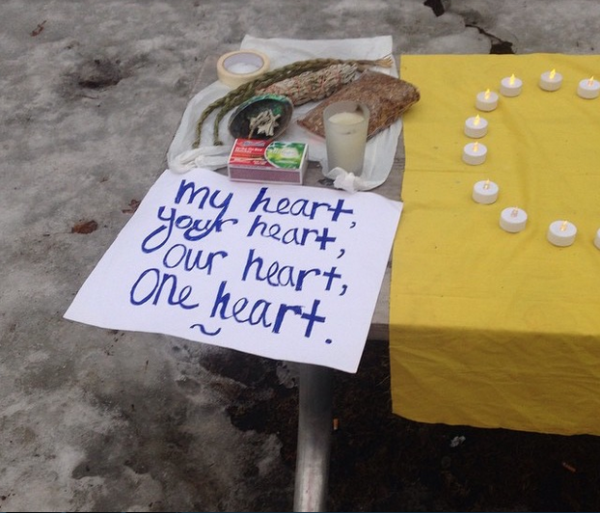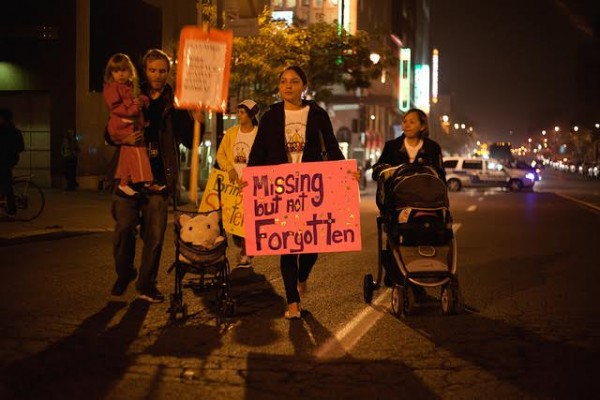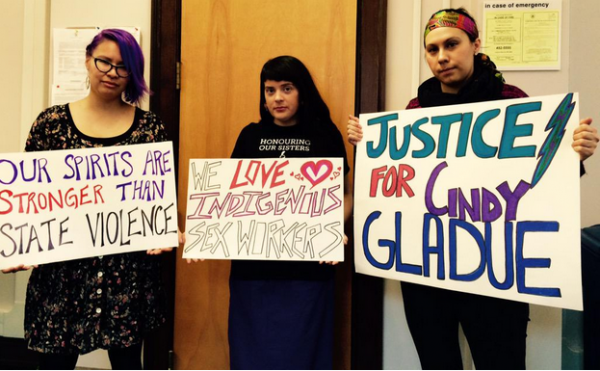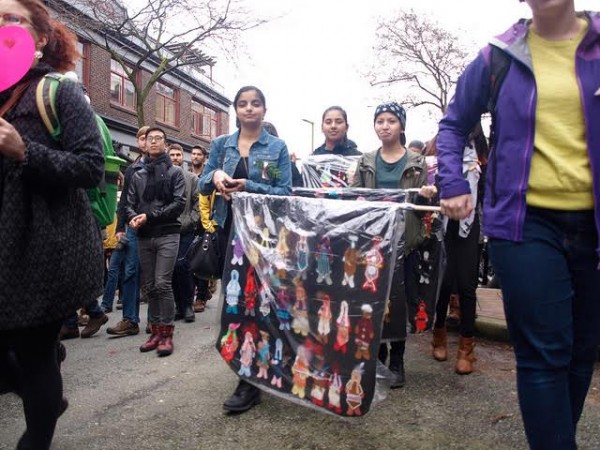
Content warning: This piece contains references to rape, murder, violence against Indigenous women (especially Indigenous sex workers), and other disturbing material.
When I told my boyfriend that I was going to write an article about Cindy Gladue and the epidemic of missing and murdered Indigenous women (MMIW), he reminded me that I should keep my bundle and medicines close to me. My elders tell me that all important activities should be entered into with good intentions and that the medicines help with this by providing strength and clarity of purpose. With that in mind, I made sure I took a moment to smudge and put out a tobacco offering before sitting down to write this. I know that writing about this is vital but it is also emotionally difficult for me. It is hard to describe through words the visceral sickening grief that I feel when I think about what was done to Cindy Gladue.
Cindy Gladue was a Nehiyaw Iskwew (Cree woman), like me. She had dropped out of high school, like me. She had worked in the sex trade, on the streets, like me. She had experienced a lot of violence and trauma in her life, like me.
On June 22nd, Cindy Gladue was found dead, naked, and covered in blood in a bathtub at the Yellowhead Inn in Edmonton, Alberta. She had bled to death from an 11cm wound on her vaginal wall. She was 36 years old.
A semi-truck driver named Bradley Barton was arrested and put on trial for her murder. Crown prosecutors argued that Cindy’s death was caused by Barton inserting a sharp object into her vagina. Barton claimed that Cindy’s vagina had been injured from him aggressively fisting her during consensual “rough sex.” Either way, Barton left the motel room for work the next morning, knowing that Cindy was in the bathtub bleeding profusely. He didn’t call 911 until hours later and lied to the police at first, saying he didn’t even know Cindy.
On March 18th, 2015 a Jury of 11 people, 9 men and 2 women acquitted Barton of first-degree murder and decided not to convict him of the lesser charge of manslaughter. There were no Native people on the jury.
I’m a filmmaker and artist with lived experience on the street and in the sex trade. I’ve never in my life studied law or criminology. I am far from an expert on court proceedings. In fact, most of my experience with the court system has been as an individual facing charges.
What I do know, though, is that people do time in prison for accidentally killing somebody in a bar fight. They can be convicted on charges for voluntary or involuntary manslaughter or criminal negligence. This is when the accused’s actions result in someone dying, even if the accused didn’t plan for or even want this person to die. I’ve known people that have been sent to prison on these types of charges.
So even in the event that Barton is telling the truth and Cindy was injured during “consensual rough sex”, why isn’t he being held responsible for killing her by accident?
Content warning: A disturbing description of the disrespectful treatment of an Indigenous woman’s remains follows.

Cindy’s genitalia were not only violated by Barton the night she died, but also during his trial. In a decision many are calling unprecedented, the prosecution chose to submit Cindy’s vagina, which had been cut out of her body and preserved for the court proceedings, as evidence. They argued that this was necessary in order to show jurors the details of the wound.
Both the chief medical examiner Graeme Dowling and an expert for the defence, Janice Ophoven, handled Cindy’s vagina in that courtroom, placing it on an overhead projector so the jurors could examine it on a large screen.
What I do know is that Cindy did not consent to this. What I do know is that her family did not consent to this. What I do know is that a room full of strangers looked at her vagina (or as the defence prefers to refer to it, her “preserved pelvis tissue”). What I do know is that she was reduced from a human being to a body part so that non-Native people could determine whether or not she had “allowed” her murder to happen to her.
What I do know is that Indigenous women are often reduced to body parts for the benefit of the colonial gaze. What I do know is that the colonial nation building project known as Canada would not have been possible without the dehumanization of Indigenous women. What I do know is that violence against Indigenous women is so normalized that missing person posters bearing our faces are as much a recognizable feature of the Canadian landscape as forests and mountain ranges. What I do know is that the abhorrent systemic violence that is the epidemic of missing and murdered Indigenous women makes me afraid to leave my house on an ongoing basis.
What I do know is that in 2014, when Prime Minister Stephan Harper was asked about the demand for a national inquiry investigating the epidemic during an end of the year interview, his response was: “Um it, it isn’t really high on our radar, to be honest…”What I do know is that the minister of Aboriginal Affairs, Bernard Valcourt, is outspoken in his belief that the epidemic is in fact the fault of Indigenous people, namely Indigenous men. When asked in an interview by the Ottawa Citizen about an inquiry to address root causes of violence against Indigenous women, his response was:
Obviously, there’s a lack of respect for women and girls on reserves…So, you know, if the guys grow up believing that women have no rights, that’s how they are treated.

Valcourt’s statement is an example of the all too prevalent victim blaming projected onto Indigenous peoples. This type of ideology contributes to injustices such as the acquittal of Bradley Barton. The truth is that violence against Indigenous women at the hands of white men is disruptive to the narrative touted by Valcourt and Harper, a narrative that states that the epidemic is the fault of Native men.
At a meeting in Calgary in March 2014, Valcourt told a group of First Nations leaders that 70% of murdered Aboriginal women were killed by Aboriginal men. He claimed that this statistic was from an upcoming Royal Canadian Mounted Police report, but when pressed, he was unable to provide proof for this number at the time of the meeting.
At first, when questioned by First Nations leaders and the media,the RCMP refused to substantiate Valcourts’ claim, stating,
In the spirit of our bias-free policing policy, the RCMP will not be disclosing statistics on the ethnicity of the perpetrators of solved Aboriginal women homicides.
However, just a week later, RCMP Commissioner Bob Paulson decided to go against policy and confirm the following in a letter to Grand Chief Bernice Martial of the Treaty 6 Nations:
The consolidated data from the nearly 300 contributing police agencies has confirmed that 70 per cent of the offenders were of aboriginal origin, 25 per cent were non-aboriginal and five per cent were of unknown ethnicity.
What I do know is that the 70% statistic only pertains to solved murders. What I do know is that if cops don’t catch a perpetrator then, obviously, the race of said perpetrator remains unknown and therefore cannot be analyzed statistically.

What I do know is that even though the statistic only applied to solved murders, the mainstream media continued to print headlines and articles the day after the RCMP statement was released that omitted this qualifier. For example, the front page headline of the April 9th Globe and Mail read “70 per cent of murdered aboriginal women killed by indigenous men.” The paper has yet to issue a correction and the RCMP continues to stand by its report. What I do know is that releasing the 70% statistic without contextualizing it implies that Indigenous men, in comparison to non-Indigenous men, are somehow particularly prone to commit random violence and murder against Indigenous women. What I do know is that the majority of murdered women, regardless of race, are killed by their current or ex husbands or intimate partners. What I do know is that Minister Valcourt used this statistic as an excuse for why there should not be a national inquiry on missing and murdered Indigenous women. As though to say that it’s Indian men killing Indian women, so therefore it’s an Indian problem and he washes his hands of the whole mess.
What I do know is that Cindy Gladue was not killed by an Indian man. Bradley Barton is a white man. I suppose, however, that Cindy Gladue’s case wouldn’t even be factored into this type of statistical analysis since, according to the courts, she wasn’t murdered at all. What I do know is that in 2002, Robert Pickton was charged with the murder of 26 women, was convicted on the murder of six in 2007, and later confessed to a cell mate that he had killed 49. Many of these women were Aboriginal and many were sex workers. What I do know is that in 2014 Cody Legebokoff was convicted of murdering an Indigenous woman—Cynthia Maas—as well as two other women and a fifteen year old girl. What I do know is that Pickton and Legebokoff, like Barton, are white men.
What I do know is that Indigenous people are enraged. We are enraged because we know that women are sacred but we must navigate a society that treats Indigenous women as little more than statistics and hashtags, bodies found in rivers, ditches, alleys and dumpsters. We live with the horror of knowing our sisters, mothers, aunties and daughters are being murdered and raped. As Indigenous women, we are forced to live with the knowledge that we are not safe in this country. We are reminded of this fact constantly, with every protest rally, every candlelight vigil, every billboard warning us not to hitchhike, every petition demanding an inquiry.

Indigenous people are constantly under pressure to prove our humanity to the general Canadian public. We see public service campaigns attempting to convince settlers to respect our basic rights—campaigns to educate settlers that in spite of prevalent stereotypes, not all missing and murdered Indigenous women are drug addicted prostitutes. These campaigns let the public know that missing and murdered Indigenous women are university students, business professionals, stay at home moms, and respected members, even leaders, of our communities. Unfortunately, in this push back against stereotypes that dehumanize us, Indigenous sex workers are being even further dehumanized and marginalized. The fact that many Indigenous university students, business professionals, stay at home moms, and respected community leaders can also be involved in the sex trade is lost. Many missing and murdered Indigenous women were never involved in sex work, but many were. Many were strippers or escorts, worked incall or the streets. I detest that begging the federal government and settler society to acknowledge the epidemic and help us has resulted in the othering, shaming, and erasure of Indigenous sex workers. All Indigenous women deserve safety and a life free from violence, whether they are doing their Master’s degree or sucking dick to pay the rent, or both.
Sex work is stigmatized in general but a specific type of anti-sex trade ideology is present within Indigenous communities and Indigenous women’s organizations which believe that sex work is inherently tied to colonization. For example, the Native Women’s Association of Canada maintains that “prostitution is not a traditional activity of Aboriginal women”and that “all sex acts performed for an exchange of money, services, for pimps, johns, in brothels or on the streets, even when the person is of the age of consent, is a form of sexual exploitation and may be deemed sex trafficked.” Sex workers and drug users can sometimes even be rejected culturally in Indigenous spaces by not being permitted to participate in certain ceremonies or handle certain items.
I am someone who has experienced trauma and violence in the context of sex work. I know that this type of thinking comes from a reactionary place of rage, grief, and the trauma of colonial violence. After all, it is a fact that Indigenous women are over-represented in survival sex work, and that intersecting forms of oppression and criminalization often find us in dangerous working conditions where we may be more vulnerable to abuse. However, promoting a moralistic meta narrative, even a self determined one, of Aboriginal women as helpless victims with no sovereignty over our own bodies does nothing to empower us. Judging and condemning the act of trading sex as inherently wrong shames Native women, resulting in further marginalization from our families and communities. A result of conflating sex work and sex trafficking is the advancement of dangerous anti-trafficking initiatives designed, purportedly, to help Indigenous workers. Anti-trafficking operations often rely heavily on heightened and aggressive policing of sex workers’ lives, leading to increased criminalization of Indigenous bodies. Fortunately, there are many Indigenous organizations that are not anti-sex work which utilize a decolonized harm reduction approach when addressing the epidemic of missing and murdered Indigenous women, such as Families of Sisters in Spirit, Native Youth Sexual Health Network, the Indigenous Sex Sovereignty Collective, and Maggies’s Aboriginal Sex Workers Outreach and Education Project.

The horrific and unjust treatment of Cindy Gladue sparked unified outrage amongst Indigenous people and allies across Canada. Letter writing campaigns and petitions demanding an appeal circulated. April 2nd, 2015 was declared a national day of action and rallies. Marches and ceremonies were held in cities all over the country, and hundreds of people came out to attend them. Many of us cried tears of joy and breathed sighs of relief on the afternoon of April 2nd at the announcement that Alberta’s crown prosecutor had filed an appeal over the acquittal of Bradley Barton. The Crown contends that the judge presiding over the trial, Justice Robert Graesser, made numerous errors in his instructions in the jury charge regarding manslaughter as well as motive. Cindy and Barton spent two nights together. Cindy died on the second night. Justice Graesser told the jury that Cindy’s consenting to sex on the first night could be used to support a finding of honest but mistaken belief in consent on the second night. So basically, because she said yes before, it meant yes every time.
What I do know is that demanding justice for Cindy does not end at this appeal. What I do know is that there wouldn’t need to be an appeal if the original verdict was just. What I do know is that there wouldn’t need to be a verdict at all if Indigenous women were safe in this country.
What I do know is that the new trial will mean putting Cindy’s three daughters, her mother, her boyfriend and the rest of her family and loved ones through horrific trauma once again. What I do know is that although we are grateful that the state has filed an appeal, this is without a doubt the absolute bare minimum of what should be done to find justice for Cindy Gladue. What I do know is that this is the same state responsible for the disgusting and dehumanizing treatment of Cindy’s body in that courtroom. When Cindy’s vagina is finished serving its purpose as “evidence”, will it be repatriated and returned to her family or is it now owned by the state?
What I do know is that Cindy’s murder, her continued violation throughout the trial, and Barton’s acquittal must act as a wake up call to the general Canadian public about the epidemic of missing and murdered Native women in this country. What I do know is that it is a horrific and tragic reminder of the value the colonial nation state places on our bodies, dead or alive.
Thank you for this powerful writing.
Thank you. That was indeed powerful and harrowing. I’m glad you mentioned self-care at the start of this article and that you were reminded you to keep your medicine close.
I had to stop reading midway, as the description of how Cindy Gladue’s body was handled by the State shocked me; something I did not think possible. The depths of Western man’s depravity knows no bounds.
Thank you for your bravery in writing about this.
Thank you for writing this. Thank you for taking care of yourself.
Thank you for sharing the names of organizations that are doing good work.
I’m so sorry that these words are even necessary to write.
[…] of violence and trauma in her life, like me.” This beautiful and harrowing piece looks at the Gladue case with intimacy and honesty. Heart wrenching and […]
What a powerfully written look at a case I wasn’t aware of – it hasn’t reached the UK media. I hope the appeal rules in her favour so that she can rest in peace.
[…] TV shows are treating sex workers’ precarious safety as entertainment, or when men brutally murder sex workers with impunity because they know this is a class of people who are not publicly […]
[…] connected, even if loosely. 10 years ago thousands of people would not have rallied for justice for Cindy Gladue. There were dozens and dozens of deaths like Cindy’s and I do not recall a single day of outrage. […]
[…] What I Do Know: The Colonial Evisceration of Cindy Gladue […]
This story has really made my heart ache. What can I do to help?
[…] What I Do Know: The Colonial Evisceration of Cindy Gladue — Tits and Sass […]